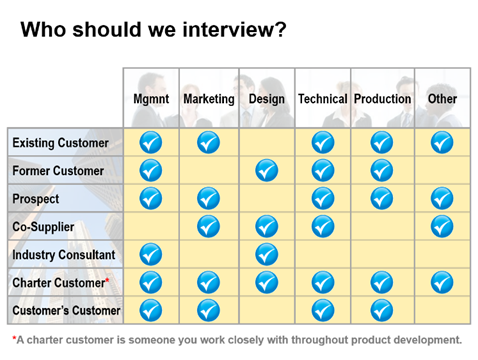- BLUE HELP
- Discovery Interviews (Step 2)
- How to plan Discovery interviews
-
Blueprinting Center & Methodology
- What is New Product Blueprinting?
- How is Blueprinting learned and applied?
- Blueprinting Center
- Blueprinting E-Learning Course
- How can I become Certified in New Product Blueprinting?
- How does Blueprinting fit with a stage-and-gate process?
- How does Blueprinting fit with strategic planning?
- How does Blueprinting fit with Design Thinking?
- How does Blueprinting fit with Lean Startup?
- How does Blueprinting fit with Minesweeper de-risking?
- How does Blueprinting fit with LaunchStar product launch?
- What innovation metrics should we use?
- What is "Jobs-to-be-Done?"
-
Blueprinter® Software
-
Market Segmentation (Step 1)
-
Discovery Interviews (Step 2)
- How to plan Discovery interviews
- Preparing your interview team
- Convincing customers to be interviewed
- How to handle confidential info in an interview
- How to conduct a Discovery interview
- Finding & using a digital projector for interviews
- How to conduct a customer tour
- How to debrief & follow-up a Discovery interview
- Engaging your sales colleagues in interviews
- Engaging distributors in interviews
- Interviewing customers down the value chain
- How to interview remotely with web-conferences
- How to interview at trade shows & other venues
- Interviewing in different global cultures & languages
- How to listen well during customer interviews
- How to probe during customer interviews
- How to gather economic data during interviews
- How to create & use Current State questions
- How to identify Must Haves (MH)
- How to select Top Picks (TP)
- How to use Trigger Maps
- How to form Outcome Statements
-
Preference Interviews (Step 3)
-
Rest of Blueprinting (Steps 4-7)
-
Everyday VOC
-
Minesweeper® De-risking
1. Deciding who to interview
Within your target market segment, determine which companies and job functions to interview.
Before beginning your Discovery interviews, your team will need a clear picture of your target market segment, also known as a “cluster of customers with similar needs.” This segment should be a) consistent with your business’s strategic intent (where you are going), b) attractive in terms of size, growth, etc., and c) properly resourced for rapid interviewing and front-end-of-innovation work. For more, see the BlueHelp articles, How to segment markets and How to select your target market segment.
Next, consider which companies and which job functions in those companies you will interview. For the companies, consider the entire ecosystem… any player that can influence market decisions or provide you with valuable insight. This typically includes potential customers, customers’ customers, industry consultants, regulatory bodies, co-suppliers, etc.

Then consider the job functions within these companies, e.g. management, marketing, design, technical, production, and so on. When you conduct your initial round of Discovery interviews, you’re trying to avoid errors of omission. In other words, you want to uncover all possible customer outcomes, even those that are normally unarticulated. This won’t happen if you fail to interview all the relevant job functions.
For more, see e-Learning Module 10: Interviewing Fundamentals at www.blueprintingcenter.com > e-Learning. For more on interviewing fundamentals, check out the 2-minute video, B2B Interviewing fundamentals, part of the B2B Organic Growth video series by Dan Adams.
Keywords: Discovery interview, New Product Blueprinting, market segment, companies to interview, job functions to interview, ecosystem to interview, charter customer
